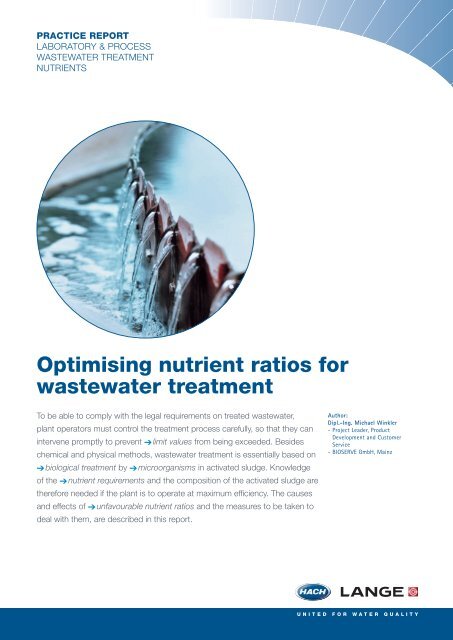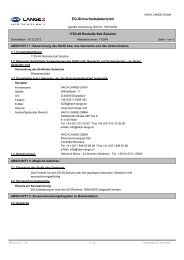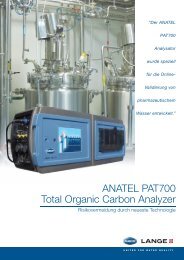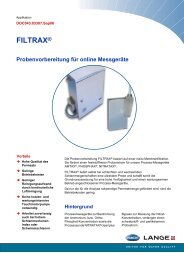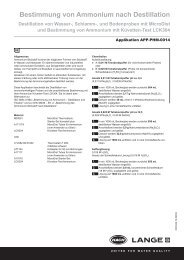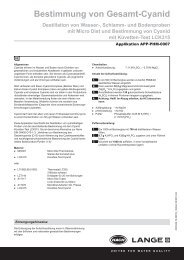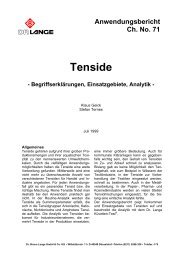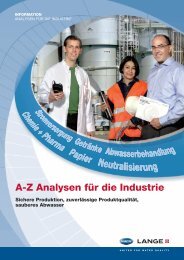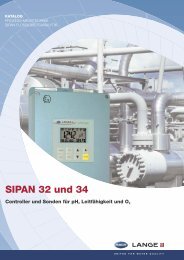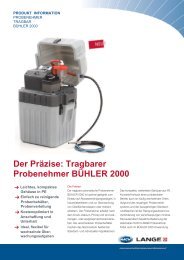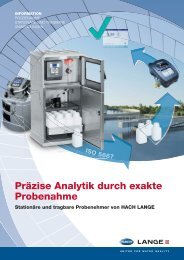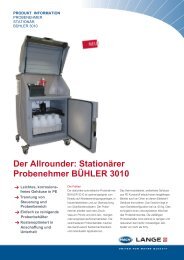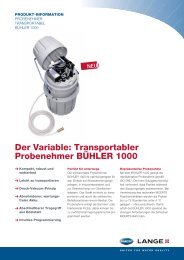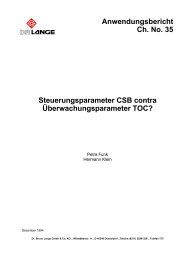Optimising nutrient ratios for wastewater treatment - HACH LANGE
Optimising nutrient ratios for wastewater treatment - HACH LANGE
Optimising nutrient ratios for wastewater treatment - HACH LANGE
You also want an ePaper? Increase the reach of your titles
YUMPU automatically turns print PDFs into web optimized ePapers that Google loves.
4<br />
NUTRIENTS_CALCULATION<br />
Controlling <strong>nutrient</strong> <strong>ratios</strong><br />
SC 1000 controller <strong>for</strong> up to eight<br />
sensors is also suitable <strong>for</strong> use as a<br />
network with Profibus<br />
Partially immersed NITRATAX<br />
sc probe <strong>for</strong> online nitrate<br />
measurement<br />
However, all sorts of industrial plants,<br />
regional differences in eating habits<br />
(disposal of different kitchen wastes<br />
through the drains), and the nature<br />
of the soil and drinking water cause<br />
<strong>wastewater</strong> to vary widely in its<br />
composition. Experience has shown that<br />
the C:N:P ratio in municipal <strong>wastewater</strong><br />
is about 100:20:5.<br />
The excess N and P compounds<br />
can usually be eliminated from the<br />
<strong>wastewater</strong> without any great difficulty<br />
using modern methods.<br />
Table 3: Causes and effects of <strong>nutrient</strong> deficiencies in the biological stage of <strong>wastewater</strong> <strong>treatment</strong><br />
Shortage of Causes/Origin of the <strong>wastewater</strong> Possible consequences Corrective action<br />
Carbon • Long dwell time in the sewerage<br />
network<br />
Far-reaching primary <strong>treatment</strong> of<br />
the <strong>wastewater</strong><br />
Industrial <strong>wastewater</strong> with a high<br />
nitrogen content, e.g. from milk and<br />
meat processing<br />
Nitrogen Low-nitrogen <strong>wastewater</strong> from:<br />
Paper industry<br />
Fruit and vegetable processing<br />
Phosphorus Landfill leachate, <strong>wastewater</strong> from<br />
fruit and vegetable processing<br />
www.hach-lange.com<br />
Table 2: Causes and effects of high sulphur concentrations<br />
Profuse development of filamentous<br />
bacteria (sludge bulking and foam)<br />
Insufficient denitrification<br />
High COD/TOC values in the inflow of<br />
the <strong>wastewater</strong> <strong>treatment</strong> plant<br />
Filamentous bacteria<br />
Increased COD/TOC values in the<br />
outflow<br />
Filamentous bacteria<br />
If the <strong>wastewater</strong> in the inflow to the<br />
biological stage is deficient in one of the<br />
main <strong>nutrient</strong>s, a wide range of problems<br />
may occur (Table 3).<br />
For efficient denitrification, a certain<br />
proportion of readily biodegradable C<br />
compounds must be present. After<br />
municipal <strong>wastewater</strong> has passed<br />
through the primary settling tank, it<br />
has a BOD 5:N ratio of 100:25 (=4). If<br />
the ratio falls below 100:40 (=2.5), the<br />
efficiency of the denitrification process<br />
is impaired, resulting in higher nitrate<br />
values in the outflow. If bypassing the<br />
primary <strong>treatment</strong> and increasing the<br />
denitrification volume fail to bring about<br />
Causes/Origin of <strong>wastewater</strong> Possible consequences Corrective action<br />
High concentrations of<br />
sulphur compounds from<br />
chemical and protein<br />
processing industries (meat<br />
and poultry processing)<br />
Anaerobic processes in the<br />
sewerage system, which<br />
cause sulphur compounds<br />
to be reduced to hydrogen<br />
sulphide<br />
Corrosion in sewers and<br />
tank walls in <strong>wastewater</strong><br />
<strong>treatment</strong> plants<br />
Neighbours suffer odour<br />
nuisance<br />
Increased growth of sulphur<br />
oxidising filamentous bacteria<br />
(Type 021 N)<br />
Avoid blockages in the<br />
sewerage network<br />
Add iron salts to the sewer<br />
(e.g. at the pumping stations)<br />
Bypass the primary <strong>treatment</strong><br />
Increase the denitrification volume while<br />
retaining sufficient volume <strong>for</strong> the nitrification<br />
(minimum sludge age of 9 days)<br />
Balance the <strong>nutrient</strong> ratio by:<br />
Addition of N compounds<br />
(good-value industrial products such as urea)<br />
Addition of domestic <strong>wastewater</strong>, turbid water<br />
from digester<br />
Balance the <strong>nutrient</strong> ratio by:<br />
Addition of P compounds (good-value industrial<br />
products such as phosphoric acid or phosphate<br />
fertilisers <strong>for</strong> the agricultural sector)<br />
Addition of domestic <strong>wastewater</strong>
NUTRIENTS_MEASUREMENT SOLUTIONS<br />
<strong>Optimising</strong> <strong>nutrient</strong> <strong>ratios</strong><br />
Measuring station <strong>for</strong> laboratory analysis<br />
DR 2800 Compact and powerful spectrophotometer with a wavelength spectrum<br />
from 340 to 900 nm <strong>for</strong> routine analysis and user applications; barcode<br />
reader (IBR) <strong>for</strong> automatic evaluation of <strong>LANGE</strong> cuvette tests; backlit<br />
graphic display with touchscreen menu guidance; mains and battery<br />
operated<br />
LT 200 Dry thermostat <strong>for</strong> standard and special digestions; preprogrammed<br />
digestions <strong>for</strong> the analysis of COD, total N, total P, TOC, organic acids,<br />
metals<br />
Alternative<br />
HT 200S High-temperature thermostat <strong>for</strong> fast digestion <strong>for</strong> the analysis of<br />
COD, total N, total P, metals in just 35 minutes; standard digestions <strong>for</strong><br />
analysis of TOC<br />
Cuvette tests Ready-to-use reagents with maximum user safety; highly precise;<br />
approved method; more than 50 parameters and measuring ranges<br />
Systems <strong>for</strong> online measurement<br />
AMTAX sc Process measuring instrument <strong>for</strong> continuous determination of the<br />
ammonium concentration in water and <strong>wastewater</strong> samples with a<br />
low solids content. The measurement is carried out by a gas-sensitive<br />
electrode.<br />
PHOSPHAX sc Process measuring instrument <strong>for</strong> continuous determination of the<br />
phosphate concentration in water and <strong>wastewater</strong> samples with a low<br />
solids content. The measurement is carried out using the vanadatemolybdate<br />
method.<br />
NH4D sc ISE ammonium probe <strong>for</strong> continuous in-fluid determination of the<br />
ammonium concentration. The measurement is carried out using an<br />
ion-selective electrode (ISE) with automatic potassium compensation.<br />
Thanks to the patented closed design (cartridge technology), the<br />
CARTRICAL ® reference system is separated from the surrounding fluid.<br />
NITRATAX sc Process probe <strong>for</strong> determining the nitrate content directly in water,<br />
<strong>wastewater</strong> or activated sludge; no sampling required; self-cleaning;<br />
reagent-free method; variety of measuring ranges<br />
SC 1000 Controller A SC 1000 controller system consists of a single LXV402 display module<br />
and one or more LXV400 probe modules. It is configured modularly<br />
to suit the customer’s specific requirements and can be expanded at<br />
any time to include additional measurement locations, sensors, inputs,<br />
outputs and bus interfaces. Each module controls up to eight sensors.<br />
Alternative<br />
SC 100 Controller Controls up to two sensors (not <strong>for</strong> AMTAX sc or PHOSPHAX sc).<br />
<strong>HACH</strong> <strong>LANGE</strong> GMBH<br />
Willstätterstraße 11<br />
D-40549 Düsseldorf<br />
Tel. +49 (0)2 11 5288-320<br />
Fax +49 (0)2 11 5288-210<br />
info@hach-lange.de<br />
www.hach-lange.de<br />
Bestellungen: 0800 208 15 97<br />
Measurement station <strong>for</strong> laboratory analysis,<br />
with DR 2800 photometer, LT 200 thermostat<br />
and <strong>LANGE</strong> cuvette tests<br />
Literature<br />
1. ATV-Handbuch: Biologische und<br />
weitergehende Abwasserreinigung,<br />
Ernst & Sohn-Verlag 1997<br />
2. K. Hänel: Biologische<br />
Abwasserreinigung mit<br />
Belebtschlamm, VEB Gustav Fischer<br />
Verlag, 1986<br />
3. K. Mudrack, S. Kunst: Biologie der<br />
Abwasserreinigung, Gustav Fischer<br />
Verlag, 1994<br />
4. Arbeitsblatt DWA A 131<br />
5. S. Kunst, C. Helmer, S.<br />
Knoop: Betriebsprobleme auf<br />
Kläranlagen durch Blähschlamm,<br />
Schwimmschlamm, Schaum,<br />
Springer-Verlag 2000<br />
6. D. Jenkins, M. G. Richard, G. T.<br />
Daigger: Manual on the causes and<br />
control of activated sludge bulking,<br />
foaming, and other solids separation<br />
problems, Lewis Publishers 2004<br />
7. Poster “Operational reliability and<br />
cost saving with <strong>HACH</strong> <strong>LANGE</strong>”,<br />
DOC140.52.00449<br />
DOC040.52.10005.May08


